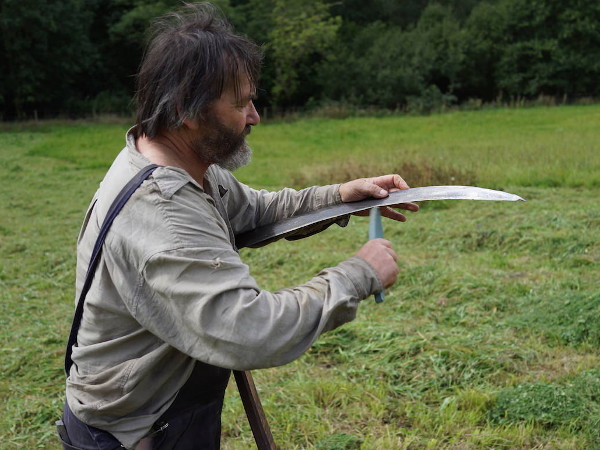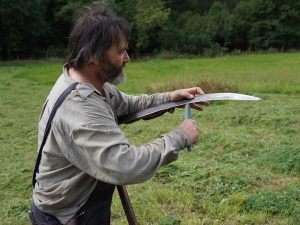“You can’t imagine what an effectual remedy it is for every sort of foolishness.”
– Levin to his brother, after a day’s scything, in Tolstoy’s Anna Karenia
Contents
What is scything?
Scything (verb): act of using a scythe (noun), a tool used for cutting crops such as grass or corn, with a long curved blade at the end of a long pole with one or two handles.
That Oxford dictionary definition hardly does credit to a versatile tool that has been around for centuries, has many land management functions, which many workers in the world still rely on for their livelihoods and which prior to the introduction of horse-drawn mowers in the UK at the end of the 19th century, was used to mow up to an acre of grass or barley, or 2 acres of oats or wheat a day.

There are many styles and traditions of scythe, from heavy wooden English or American style snaths (handles) to sleek-looking lightweight aluminium shafts. Some are available at agricultural merchants. All will do the job, but we recommend Austrian scythes. They are easier to handle and maintain and no more expensive and than traditional English scythes; they are robust, and the blade quality is renowned. In fact some blades are still hand-forged in a factory with 500 years of experience, some from English steel. Sadly, none are now produced in the UK, even for ‘English’ style snaths, despite a long tradition of scythe blade manufacture, particularly in Sheffield.
What are the benefits of scything?
To the wider environment: fewer internal combustion engines! No pollution, no fossil fuels, less embodied energy in the manufacturing process and a longer life. Their versatility can replace more than one machine, not to mention reduce the use of selective herbicides.

To the local environment: less noise disturbance, less compaction / disturbance of soil, no more strimmed saplings, wildlife has more time to get out of the way and the operator has more time to avoid it.
To the user: cleaner, quieter, no vibration, no flying stones, more control and can be used in (almost) any weather. With good technique, scything is good physical exercise and can be meditative and peaceful. With no need for all that protective gear you can be part of nature while you work.
Fossil-fuel-powered flail mower (costing several thousand pounds new) versus man with scythe.
Oh, and then there is the financial reward. A cheap scythe can be as little as £60, but it’s worth considering an Austrian scythe for about £100, or £160 in a set including a maintenance kit and second blade (see resources). This should last a lifetime, depending on use. Compare that with the cost and life-expectancy of a mower, and a strimmer, and a power scythe.
So why are there so many old wooden snaths with huge bent blades abandoned in sheds and barns? Partly of course due to changes in agricultural practice, such as increased farm size and reduced workforce, but also due to bad scything! We have lost knowledge, skills and experience. A poor scythe, poor maintenance and / or poor technique, can lead to an exhausting, inefficient and unproductive experience.

What can I do?
First decide if the machinery that has replaced them is better, or is there still a place for scythes? By careful choice of blade type and size, scythes can be used for a wide variety of tasks around farm and garden. Their versatility can replace the need for mower, strimmer or power scythe for weed control amongst cultivated plants and trees; maintaining awkward areas like bumpy and uneven ground, fence lines, banks, ditches and narrow grass paths; mowing lawns, green manure crops, cereals or hay.
Choice of snath and blade, setting up, maintenance and technique are all key to successful scything. A scythe must be set up for the individual user, so if you’re going to share a scythe, make sure the handles are easily adjustable. Even so there are limits; different height operators may need different length snaths, so choose carefully and get advice on setting up handle positions.
There are different blades for different jobs. Grass blades are available in various lengths, from about 90cm for experienced scythers cutting hay, to 40cm for delicate cutting around cultivated plants. In general, bigger blades are only good for fairly level open land, so it is probably worth having at least two sizes, possibly 70-75cm for mowing and 55cm for those tight corners. There are also specialist blades, such as tougher ones for jobs like ditching or cutting brush.
Blades must be sharp. The edge is kept keen during use by honing with a fine whetstone, and peening is needed when the blade has been honed back to thicker metal. Peening is a technique of ‘cold forging’ the blade thinner using a hammer and anvil. This may sound challenging, but can be done in the field and is a much simpler and cheaper skill than maintaining an internal combustion engine! There’s little pleasure in scything with poor technique. Slashing the face of the blade into the vegetation is unproductive, frustrating and can be damaging to both scythe and operator. Learning to create a swath with a smooth sweeping action is both satisfying and efficient.

Be part of a revival in scything knowledge in the UK. See it as a way forward, not back. Stop and think scythe before buying a machine! Can a scythe do what I want? Think you might buy one, or resurrect that old one that’s been lying around for years, or even make your own? There are courses to learn how to set up, maintain and use your scythe correctly.
Remember, the right scythe, good maintenance and good technique will lead to exhilarating working experience and satisfying results. However, do beware – you might find yourself totally hooked and having extra fun at scythe festivals!
Specialist(s)
Thanks to Phil Batten of Scythe Cymru for information.
The specialist(s) below will respond to queries on this topic. Please comment in the box at the bottom of the page.

Simon Fairlie is the author of Meat: A Benign Extravagance, and The Rural Planning Handbook. He runs a micro-dairy at Monkton Wyld Court Community in Dorset, and the Scythe Shop, offering Austrian scythes and beginners’ scything courses.



1 Comment
I’ve been using an electric weed Wacker to manage my small lawn. Considering switching after viewing your site. I imagine it’ll look much better this way!